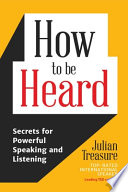

Authentic communication is the foundation of being heard. In today's world, where information is abundant and attention spans are short, conveying one's thoughts and ideas in a genuine manner is crucial. The author emphasizes the necessity of understanding one's own voice and the values behind it. Authenticity fosters trust and connection, which are essential for effective communication. When individuals communicate authentically, they resonate with their audience, making it easier for their messages to be received and understood. The book provides strategies for self-reflection and understanding one's unique communication style, encouraging readers to embrace vulnerability as a strength in their interactions.
Continue readingTo be heard, it is vital to know who you are speaking to. The book discusses the significance of audience analysis, which involves understanding the demographics, interests, and needs of your listeners. Tailoring your message to fit the audience's preferences can significantly enhance the effectiveness of your communication. The author provides tools and techniques for conducting audience research, including surveys, interviews, and social media analysis. By aligning your message with the audience's values and expectations, you increase the likelihood of engaging them and ensuring that your voice is heard.
Continue readingStorytelling is identified as a powerful tool for communication. The book illustrates how stories can captivate audiences and make complex ideas more relatable. By weaving personal anecdotes or relevant narratives into your communication, you can create emotional connections that resonate with listeners. The author outlines the components of effective storytelling, including structure, character development, and emotional appeal. Moreover, the book emphasizes the importance of authenticity in storytelling, encouraging readers to share their genuine experiences to foster deeper connections with their audience.
Continue readingBeing heard is not just about speaking; it also involves listening. The book highlights the importance of active listening as a fundamental component of effective communication. Active listening entails fully engaging with the speaker, providing feedback, and demonstrating understanding. The author shares techniques for improving listening skills, such as maintaining eye contact, summarizing what has been said, and asking clarifying questions. By cultivating these skills, individuals can create a more inclusive environment where all voices are valued, leading to richer discussions and more meaningful exchanges.
Continue readingThe book delves into the significance of nonverbal cues in communication. Body language, facial expressions, and tone of voice can greatly influence how messages are received. The author discusses the concept of congruence, where verbal and nonverbal messages align, creating a more powerful communication impact. Readers are encouraged to become aware of their own nonverbal signals and to interpret those of others. By mastering nonverbal communication, individuals can enhance their overall effectiveness in conveying their messages and being heard.
Continue readingFor effective communication to occur, it is essential to create a safe space where individuals feel comfortable expressing their thoughts and feelings. The book emphasizes the role of psychological safety in fostering open dialogue. The author provides strategies for creating such an environment, including encouraging diverse perspectives, showing empathy, and refraining from judgment. By establishing trust and safety, individuals can engage in more meaningful conversations, leading to better understanding and collaboration.
Continue readingFeedback is a critical element of effective communication. The book discusses how constructive feedback can enhance understanding and improve communication skills. The author outlines methods for giving and receiving feedback effectively, emphasizing the importance of specificity, timing, and a positive approach. By embracing feedback as a tool for growth, individuals can become more adept communicators and foster a culture of continuous improvement in their interactions.
Continue reading